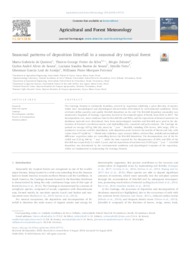Seasonal patterns of deposition litterfall in a seasonal dry tropical forest.
Seasonal patterns of deposition litterfall in a seasonal dry tropical forest.
Author(s): QUEIROZA, M. G. de; SILVA, T. G. F. da; ZOLNIER, S.; SOUZA, C. A. A. de; NETOD, S.; FERREIRA, W. P. M.
Summary: The Caatinga Domain is exclusively Brazilian, covered by vegetation exhibiting a great diversity of species, which have morphological and physiological characteristics determined by environmental conditions. These attributes define quantity and quality litterfall deposition on the soil. The litterfall deposition seasonality was monitored a fragment of Caatinga vegetation, located in the semiarid region of Brazil, from 2016 to 2017. The decomposition rate, mean residence time for litterfall (50 and 95%), and the exportation of mineral nutrients via deciduous material were determined. Data from meteorological variables and litterfall were used in the elaboration of Pearson's correlation matrix, and multicollinearity, canonical and path analyzes. The Caatinga deposited on average 637 kg DM (dry mass) ha−1 year−1 litterfall, including 53% leaves, 26% twigs, 15% reproductive structures and 6% miscellanea, with deposition peaks between the months of March and July, with values above 57 kg MS ha−1. Global solar radiation, vapor pressure deficit, soil heat flux, rainfall and normalized difference vegetation index are controlling factors the litterfall deposition. The decomposition rate of the litterfall was 0.33 kg DM ha−1 year−1, while the time required for the disappearance of 50% and 95% of the litterfall was respectively 2.1 and 9.1 years, and the exportation of nutrients was 13.59 kg ha−1 year−1. Litterfall deposition was determined by the environmental conditions and physiological responses of the vegetation, which are fundamental to maintaining the Caatinga Domain.
Publication year: 2019
Types of publication: Journal article
Unit: Embrapa Coffee
Observation
Some of Embrapa's publications are published as ePub files. To read them, use or download one of the following free software options to your computer or mobile device. Android: Google Play Books; IOS: iBooks; Windows and Linux: Calibre.
Access other publications
Access the Agricultural Research Database (BDPA) to consult Embrapa's full library collection and records.
Visit Embrapa Bookstore to purchase books and other publications sold by Embrapa.

